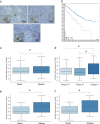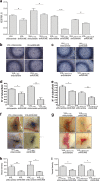von Hippel-Lindau mutants in renal cell carcinoma are regulated by increased expression of RSUME
- PMID: 30890701
- PMCID: PMC6424967
- DOI: 10.1038/s41419-019-1507-3
von Hippel-Lindau mutants in renal cell carcinoma are regulated by increased expression of RSUME
Abstract
Renal cell carcinoma (RCC) is the major cause of death among patients with von Hippel-Lindau (VHL) disease. Resistance to therapies targeting tumor angiogenesis opens the question about the underlying mechanisms. Previously we have described that RWDD3 or RSUME (RWD domain-containing protein SUMO Enhancer) sumoylates and binds VHL protein and negatively regulates HIF degradation, leading to xenograft RCC tumor growth in mice. In this study, we performed a bioinformatics analysis in a ccRCC dataset showing an association of RSUME levels with VHL mutations and tumor progression, and we demonstrate the molecular mechanism by which RSUME regulates the pathologic angiogenic phenotype of VHL missense mutations. We report that VHL mutants fail to downregulate RSUME protein levels accounting for the increased RSUME expression found in RCC tumors. Furthermore, we prove that targeting RSUME in RCC cell line clones carrying missense VHL mutants results in decreased early tumor angiogenesis. The mechanism we describe is that RSUME sumoylates VHL mutants and beyond its sumoylation capacity, interacts with Type 2 VHL mutants, reduces HIF-2α-VHL mutants binding, and negatively regulates the assembly of the Type 2 VHL, Elongins and Cullins (ECV) complex. Altogether these results show RSUME involvement in VHL mutants deregulation that leads to the angiogenic phenotype of RCC tumors.
Conflict of interest statement
The authors declare that they have no conflict of interest.
Figures






Similar articles
-
RSUME inhibits VHL and regulates its tumor suppressor function.Oncogene. 2015 Sep 10;34(37):4855-66. doi: 10.1038/onc.2014.407. Epub 2014 Dec 15. Oncogene. 2015. PMID: 25500545
-
Renal cell carcinoma- and pheochromocytoma-specific altered gene expression profiles in VHL mutant clones.Oncol Rep. 2005 Jun;13(6):1033-41. Oncol Rep. 2005. PMID: 15870918
-
Up-regulation of hypoxia-inducible factors HIF-1alpha and HIF-2alpha under normoxic conditions in renal carcinoma cells by von Hippel-Lindau tumor suppressor gene loss of function.Oncogene. 2000 Nov 16;19(48):5435-43. doi: 10.1038/sj.onc.1203938. Oncogene. 2000. PMID: 11114720
-
MicroRNAs Associated with Von Hippel-Lindau Pathway in Renal Cell Carcinoma: A Comprehensive Review.Int J Mol Sci. 2017 Nov 22;18(11):2495. doi: 10.3390/ijms18112495. Int J Mol Sci. 2017. PMID: 29165391 Free PMC article. Review.
-
VHL and HIF signalling in renal cell carcinogenesis.J Pathol. 2010 Jun;221(2):125-38. doi: 10.1002/path.2689. J Pathol. 2010. PMID: 20225241 Review.
Cited by
-
Genetics, Pathophysiology, and Current Challenges in Von Hippel-Lindau Disease Therapeutics.Diagnostics (Basel). 2024 Aug 29;14(17):1909. doi: 10.3390/diagnostics14171909. Diagnostics (Basel). 2024. PMID: 39272694 Free PMC article. Review.
-
EHD2, a novel HIF target gene, is a promising biomarker in clear cell renal cell carcinoma.Int J Clin Exp Pathol. 2023 Nov 15;16(11):344-351. eCollection 2023. Int J Clin Exp Pathol. 2023. PMID: 38059172 Free PMC article.
-
The Role of VHL in the Development of von Hippel-Lindau Disease and Erythrocytosis.Genes (Basel). 2022 Feb 17;13(2):362. doi: 10.3390/genes13020362. Genes (Basel). 2022. PMID: 35205407 Free PMC article. Review.
-
VHL Ser65 mutations enhance HIF2α signaling and promote epithelial-mesenchymal transition of renal cancer cells.Cell Biosci. 2022 May 3;12(1):52. doi: 10.1186/s13578-022-00790-x. Cell Biosci. 2022. PMID: 35505422 Free PMC article.
-
The emerging roles of SUMOylation in the tumor microenvironment and therapeutic implications.Exp Hematol Oncol. 2023 Jul 6;12(1):58. doi: 10.1186/s40164-023-00420-3. Exp Hematol Oncol. 2023. PMID: 37415251 Free PMC article. Review.
References
-
- Nordstrom-O’Brien M, et al. Genetic analysis of von Hippel-Lindau disease. Hum. Mutat. 2010;31:521–537. - PubMed
Publication types
MeSH terms
Substances
LinkOut - more resources
Full Text Sources
Medical
Molecular Biology Databases

